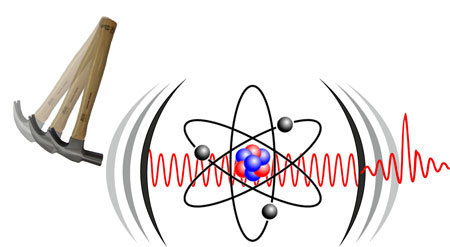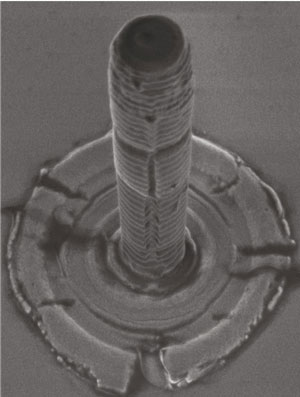| Sep 27, 2013 |
Superfast switching of quantum light sources
|
|
(Nanowerk News) Spontaneous emission of light from excited sources, such as atoms, molecules or quantum dots, is a fundamental process with many applications in modern technology, such as LEDs and lasers. As the term 'spontaneous emission' indicates, the emission is random in nature and it is therefore impossible to predict the exact emission time of a photon. However, for several applications it is desirable to receive single photons exactly when they are needed with as little uncertainty as possible. This property is crucial for ultra-secure communication using quantum cryptography and in quantum computers. Therefore, the important goal is to fabricate a quantum light source such that it emits a single photon exactly at a desired moment in time.
|
 |
| Cartoon of the superfast emission of a light source. The light source is embedded in an optical resonator where it spontaneously emits a photon. During the emission of the photon the favored color of the resonator is quickly switched – symbolized by a hammer to match the color of the light source. During this short interval the light source is triggered to emit an ultrashort burst of photons within a desired moment in time.
|
|
Switching light emission
|
|
The average emission time of quantum light sources can be reduced by locating them in various nanostructures, like optical resonators or waveguides. But the distribution of emission times is always exponential in time in a usual stationary environment. In addition, the smallest uncertainty in the emission time is limited by both the maximum intensity in the resonator and the variations in the preparation time of the emitter.
|
|
The Dutch-French team proposes to overcome these limitations by quickly switching the resonator length, in which the light source is located ("Non-exponential spontaneous emission dynamics for emitters in a time-dependent optical cavity"). The time duration of the switch should be much shorter than the average emission time. The result is that the favored color of the resonator only matches the emission color of the light source within a short time interval. Only within this short time frame are the photons emitted by the light source into the resonator.
|
|
Ultrafast light source
|
|
The researchers propose to use quantum dot light sources, which can easily be integrated in semiconductor optical resonators with lengths on the order of microns.
|
|
The switching of the resonator will be achieved by shining an ultrashort laser pulse at the micropillar resonator during the emission time of the quantum dots. This quickly changes the refractive in the resonator and thereby the effective resonator length. The switching time can be directly controlled by the arrival time of the short laser pulse and by the lifetime of the excited electrons.
|
 |
| SEM picture of a semiconductor micropillar with a diameter of 1 µm. It consists of a central GaAs l-layer sandwiched between two Bragg stacks made from alternating layers of GaAs and AlAs. The structures are made in Grenoble by molecular-beam-epitaxy (MBE) and subsequent nanostructuring
|
|
These controlled light switches have great prospects for creating incoherent ultrafast light sources for fast stroboscopes without laser speckle, in quantum cryptography, in quantum information and for studying ultrafast cavity Quantum electrodynamics.
|
|
The team
|
|
The research has been performed by FOM postdoc Dr. Henri Thyrrestrup, Dr. Alex Hartsuiker and FOM workgroup leader Prof.dr. Willem L. Vos from the Complex Photonic Systems (COPS) Chair at the MESA+ Institute for Nanotechnology of the University of Twente in Enschede, The Netherlands, in close collaboration with Prof.dr. Jean-Michel Gérard from the Institute for Nanoscience and Cryogeny (CEA/INAC) in Grenoble, France.
|


